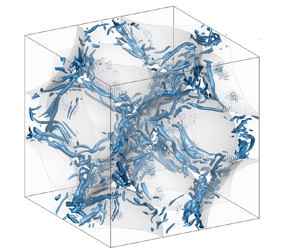Article contents
Clustering of inertial particles in turbulent flow through a porous unit cell
Published online by Cambridge University Press: 22 February 2022
Abstract

Direct numerical simulation is used to investigate effects of turbulent flow in the confined geometry of a face-centred cubic porous unit cell on the transport, clustering and deposition of fine particles at different Stokes numbers ( $St = 0.01, 0.1, 0.5, 1, 2$) and at a pore Reynolds number of 500. Particles are advanced using one-way coupling and the collision of particles with pore walls is modelled as perfectly elastic with specular reflection. Tools for studying inertial particle dynamics and clustering developed for homogeneous flows are adapted to take into account the embedded, curved geometry of the pore walls. The pattern and dynamics of clustering are investigated using the volume change of Voronoi tesselation in time to analyse the divergence and convergence of the particles. Similar to the case of homogeneous, isotropic turbulence, the cluster formation is present at large volumes, while cluster destruction is prominent at small volumes and these effects are amplified with the Stokes number. However, unlike homogeneous, isotropic turbulence, the formation of a large number of very small volumes was observed at all Stokes numbers and attributed to the collision of particles with the pore wall. Multiscale wavelet analysis of the particle number density indicates that the peak of the energy density spectrum, representative of enhanced particle clustering, shifts towards larger scales with an increase in the Stokes number. Scale-dependent skewness and flatness quantify the intermittent void and cluster distribution, with cluster formation observed at small scales for all Stokes numbers, and void regions at large scales for large Stokes numbers.
$St = 0.01, 0.1, 0.5, 1, 2$) and at a pore Reynolds number of 500. Particles are advanced using one-way coupling and the collision of particles with pore walls is modelled as perfectly elastic with specular reflection. Tools for studying inertial particle dynamics and clustering developed for homogeneous flows are adapted to take into account the embedded, curved geometry of the pore walls. The pattern and dynamics of clustering are investigated using the volume change of Voronoi tesselation in time to analyse the divergence and convergence of the particles. Similar to the case of homogeneous, isotropic turbulence, the cluster formation is present at large volumes, while cluster destruction is prominent at small volumes and these effects are amplified with the Stokes number. However, unlike homogeneous, isotropic turbulence, the formation of a large number of very small volumes was observed at all Stokes numbers and attributed to the collision of particles with the pore wall. Multiscale wavelet analysis of the particle number density indicates that the peak of the energy density spectrum, representative of enhanced particle clustering, shifts towards larger scales with an increase in the Stokes number. Scale-dependent skewness and flatness quantify the intermittent void and cluster distribution, with cluster formation observed at small scales for all Stokes numbers, and void regions at large scales for large Stokes numbers.
Information
- Type
- JFM Papers
- Information
- Copyright
- © The Author(s), 2022. Published by Cambridge University Press
References
REFERENCES
- 6
- Cited by


